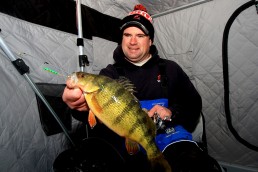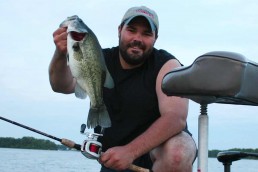What to do When the Go-to Panfish Bite Goes Deep
SHARE THIS POST
On many fisheries go-to panfish bites can take place out over deeper water. North Dakota’s Devils Lake often sees deep-water basin patterns develop in 40 feet. We’ve even found deep-crappie patterns on Rainy Lake over 50 feet. Panfish locations in over 25 feet of water are fairly common too whenever deep, soft-bottom basins exist. Panfish can typically suspend over these deep locations in 15, 20, or even 30 feet, while other fisheries may see them at the very bottom along the floor under 30 feet of water.
One of the most important variables influencing how you fish and the presentation you use is water clarity. Stained water creates different challenges over deeper water. Over deep, stained water you can mark fish on your electronics all day, but the fish open up only during short windows where sun offers good light penetration. We see this scenario on Devils Lake when fishing over deeper water. Our best deep-water perch days are often with a high sun, but even here there might be a couple of narrow windows in the day where fish are eating more.
The visibility you encounter when using an underwater camera over deeper water is a good litmus test. Usually, we use underwater cameras to see something in the clearer water, but they also reveal valuable information when you can’t see as well. Whenever you find yourself in a situation when visibility is inhibited, you know then you need to make adjustments to your presentation. So often over water with good visibility we’ll fish above the fish and attempt to establish what the ceiling is for them. But it’s not uncommon to see fish rise 5 feet or more to reach your presentation. And when visibility is extremely limited, you now know you are going to have to place your presentation at the level of the fish and not expect any ceiling.
Another presentation adjustment is the jig stroke. High lifts and sharp jig strokes can literally disappear in the abyss, so this jig stroke has to become much tighter so your presentation can become more visible by keeping it in that one spot. Because of the lack of visibility combined with depth, larger profiles are great for enabling these deeper fish to find you, but the challenge is getting fish to eat too big of a profile.
Deeper water creates serious challenges for distinguishing a bite. Whether you are using a spring bobber or a finesse glass rod, you don’t actually see the fish suck the hook. You see a rod tip drop or a spring load up when a fish moves away from the hole in deeper water when you have 30 feet of line out. Imagine a fish sucking in a hook and coasting about 1 foot and then one-half foot from a hole—that is what it takes to drop a spring when fishing over said 30 feet. And, this is why larger profiles create some challenges. The fish can see and find the larger profile, but they might not take that lure or bait and swim off with it far enough to distinguish the bite.
Are you enjoying this post?
You can be among the first to get the latest info on where to go, what to use and how to use it!
On the tougher bites, one of the best presentations I’ve ever found for this scenario is a spoon with a chain dropper. A classic favorite for deep-water perch anglers, this same presentation also shines for crappies and bluegills whenever in deep water and visibility is compromised.
When light penetration is limited there are three basic color schemes most productive: glow, dark and gold. Good glow paint can make a huge difference, particularly when it’s overcast or no high sun. Dark colors of blue, purple or black and while might lack shelf appeal, but they are deadly over deep water and are underrated. Gold remains visible over deeper water and shines if there is any sun. On overcast days with little sun, I have made a habit of avoiding certain patterns and would much rather opt to fish much shallower patterns, even if there are notably fewer fish.
When there is sun though, this is where live bait will often trump soft plastics because you need the fish to take the bait in their mouths and carry it as far as possible, or with which is close to the deadstick approach. In water deeper than 25 feet, I also believe braided line in 4- or 6-pound-test can give you an edge over monofilament, particularly when hooking up with fish. Monofilament just has too much stretch. You can use a mono or fluorocarbon leader, but the leader is not always necessary. This is also a situation where a spinning reel shines because of the gear ratio and speed that’s necessary to get back down to the fish.
I also don’t target deep fish when I don’t plan on keeping fish for the table, as most panfish pulled from 30 feet are going to suffer trauma. Deep patterns are typically catch and kill, and you need to decide with your own circumstances whether this is ethical. If there are a lot of small fish or unintended species, I often choose to move on. Because of the depth, you can also often shake fish off that either feels too small—6-inch perch—or too big like an accidental walleye that feels over 20 inches by using a single hook and pinching down the barb. On many of the larger, more established perch fisheries in the Dakotas, however, many of our bites are over basins and transitions deeper than 20 feet and if the basin is 30 or 40 feet, as is in the case of Devils Lake where some of the basin is around 50 or deeper. And, sooner or later, you are going to find yourself in a situation where you are fishing in water deeper than 25 feet.
MWO
SHARE THIS POST
Did you enjoy this post?
You can be among the first to get the latest info on where to go, what to use and how to use it!
Jason Mitchell
Jason Mitchell was a top walleye guide on Devils Lake, N.D. for nearly 20 years. Today, Mitchell produces the Jason Mitchell Outdoors TV program. Visit jasonmitchelloutdoors.com for more.



